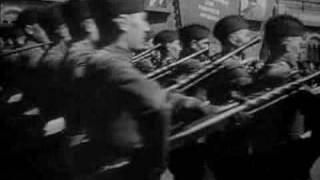By John Wear
Mission to Moscow Movie Review
The book Mission to Moscow praised Josef Stalin’s tough-minded ability to protect himself from internal threat. Published in 1941, Mission to Moscow provided welcome reassurance to the American public that their democracy was in alliance with a fair-minded and trustworthy Soviet leader. The book became a runaway international success, selling 700,000 copies in the United States alone, and topping the bestseller lists in the 13 languages into which it was translated.[1]
Mission to Moscow was turned into a Hollywood movie in 1943 at a time when American media was celebrating Soviet military triumphs. State Department experts on the Soviet Union called the movie:
one of the most blatantly propagandistic pictures ever seen.”


Former U.S. Ambassador to the Soviet Union Joseph Davies appears at the beginning of the movie telling everyone that Stalin was devoted to world peace. Davies portrays Stalin as a man of high integrity who bravely fought the evil plans of Adolf Hitler to conquer the world. Stalin awarded Joseph Davies the Order of Lenin in May 1945 for his contribution to “friendly Soviet-American relations.”[2]
Original trailer:
What does the movie Mission to Moscow get wrong?
- The movie Mission to Moscow portrays Stalin as a man of peace and Hitler as an aggressor out to conquer the world. The truth is that Hitler’s invasion of the Soviet Union prevented Stalin from conquering all of Europe. (Source: Germany’s War, Chapter One, pp. 15-59).
- The movie Mission to Moscow portrays U.S. Ambassador to the Soviet Union Joseph Davies presenting peace-loving President Roosevelt’s disarmament plan to German economist Hjalmar Schacht. Of course, this plan is rejected by Germany since Germany is out to conquer the world. The truth is that President Roosevelt did not want peace. Roosevelt had always wanted war and did everything in his power to bring about war. (Source: Germany’s War, Chapter Two, pp. 61-105).
- The movie shows Joseph Davies traveling around the Soviet Union assessing the Soviet Union’s military and industrial power. While Ambassador Davies does see some of the Soviet military buildup, the movie does not reflect information Davies reported to President Roosevelt on April 1, 1938. In this report, Davies complained of the gigantic Soviet expenditures for defense, totaling approximately 25% of the Soviet Union’s total income in 1937. Davies reported that Stalin, in a letter to Pravda on February 14, 1938, had confirmed his intention to spread Communism around the world. Stalin also promised in his letter that the Soviet Union would work with foreign Communists to achieve this goal. Stalin concluded in his letter, “I wish very much…that there were no longer on earth such unpleasant things as a capitalist environment, the danger of a military attack, the danger of the restoration of capitalism, and so on.” Davies stated in his report that the Soviet Union could best be described as “a terrible tyranny.”[3]
- The movie gives a one-sided positive view of the Moscow trials, rationalizes the Soviet Union’s participation in the Molotov-Ribbentrop Pact and its unprovoked invasion of Finland, and portrays the Soviet Union as a nation moving toward democracy and international peace and cooperation. (Source: https://en.wikipedia.org/wiki/Mission_to_Moscow).
- The movie portrays the defendants in the Moscow trials as guilty in Davies’ view. It also showed some of the purges as an attempt by Stalin to rid his country of pro-German fifth columnists. Some fifth columnists are described in the film as acting on behalf of Germany and Japan. The film defends the purges, complete with a quarter-hour dedicated to arguing that Leon Trotsky was a Nazi agent. In the film, Davies proclaims at the end of the trial scene: “Based on 20 years’ trial practice, I’d be inclined to believe these confessions.” (Source: https://en.wikipedia.org/wiki/Mission_to_Moscow).
Stalin is heralded by the US Ambassador as “a great builder for the benefit of man kind”:
Wears War Verdict for the Movie:

Strong thumbs down. This movie is a joke even by Hollywood standards.

Fortunately, the movie lost money and was not a commercial success. Mission to Moscow’s numerous factual inaccuracies and outright false portrayals of Soviet leaders and events resulted in criticism from those on both the left and the right of the political spectrum. (Source: https://en.wikipedia.org/wiki/Mission_to_Moscow).
Suggested Reading:
Nuremberg Farce – Quote #17: Freshening Stalin’s Murderous Image & The Great Purge Trials For Nuremberg: “When Hitler’s invasion of Russia in June 1941 transformed Stalin from a confederate of Hitler into an ally of Britain, it became imperative to expunge from public memory all recollection of what was known concerning him and the grim police state which he had established in Russia. This was successfully accomplished by the invention of the Great Stalin Myth. In place of the ruthless tyrant whose character was finally revealed to the world in 1956 by his successor, Nikita Khrushchev, there was held up for public admiration the benign figure of “Uncle Joe Stalin”, the champion of liberty and lover of all mankind, the loyal ally who was inspired by the same lofty ideals as Churchill and Roosevelt. To preserve public belief in the Stalin Myth it was absolutely imperative that no mention of any kind should be made of the Great Purge.”
How Stalin Conspired To Foment WWII & Infiltrate The U.S. Government
How FDR Forced Hitler To Declare War On America
ENDNOTES
[1] Tzouliadis, Tim, The Forsaken: An American Tragedy in Stalin’s Russia, New York: The Penguin Press, 2008, p. 147.
[2] Dobbs, Michael, Six Months in 1945, New York: Alfred A. Knopf, 2012, p. 215.
[3] Hoggan, David L., The Forced War: When Peaceful Revision Failed, Costa Mesa, CA: Institute for Historical Review, 1989, p. 423.
Source Article from http://www.renegadetribune.com/mission-moscow-factual-movie-president-roosevelt-wanted-made-russian-people-thought-comedy/
Related posts:
Views: 0
 RSS Feed
RSS Feed

















 January 25th, 2018
January 25th, 2018  Awake Goy
Awake Goy 

 Posted in
Posted in  Tags:
Tags: 
















